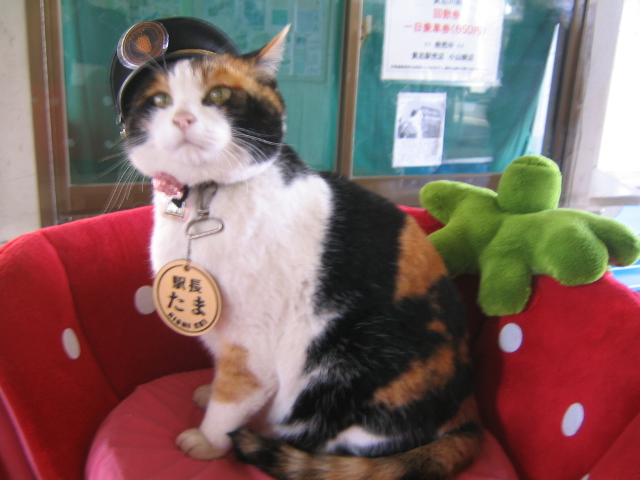The Station Master
In April of 2006, the Wakayama Electric Railway in Japan was on the verge of an economic collapse. That often leads to layoffs and this was no exception. That month, the subway line fired all of its employees working out of stations on its Kishigawa Line, a 14-station line which services a nearly 10-mile span running across Wakayama Prefecture. The stations, for the first time in company history, had no station masters.
Less than two years later, though, one of the stations — Kishi Station in Kinokawa — had a station master again. And not just a regular station master, either — it had the line’s first “super station master,” a new position designed to show just how important this employee was to the company. Her name was Tama and the company proudly announced that she was the company’s first female to reach such a high level in the company.
Which is kind of offensive because Tama is a cat.

Tama was a stray, born in 1999, who hung around the station for the first few years of her life, unemployed but not really looking for work, given that she was a cat. She had a good gig going on regardless, as she was regularly fed by passengers and employees of local businesses. That threatened to dry up in 2006, when Wakayama Electric cut back and scheduled Kishi Station for closure. Locals and commuters pushed back (not to save the cat, but to save their own method of transport), and while the station remained open, the people who worked there lost their jobs. A local man (who had a different job nearby) named Toshiko Koyama was hired as a freelance station master — basically a greeter — on a very part-time basis; effectively, it was a way for someone with a full-time gig elsewhere to pull in some extra spending money. Koyama adopted Tama and had her with him during his greeting duties, and before long, people came to the station to see the cat who was a de facto assistant station master.
In early 2007, Wakayama Electric decided to make Tama official. They hired her (to the extent that one can, in fact, hire a cat) as the station master, paying her in cat food. The response was a boon for the flailing company, which saw a 10% boost in ridership (not all attributable to a cat, of course), and Tama became a good luck charm. Less than 18 months later, she was promoted to the title of super station master and given her own office — a converted ticket-taker booth, now with a litter box. She also received a really cool station master hat, as seen above, and was lauded as “the only female in a managerial position” in the 36-person (cats excluded) company, according to Independent News (South Africa).
Around the same time, Wakayama Electric expanded — not its operations, but its litter of cat-employees. Tama’s mother, Miiko, and another cat, Chibi, joined her as assistant station masters. (Miiko’s tenure was short-lived, as she passed away in 2009.) And then, being a highly valued employee, Tama got another promotion. In 2010, she was made the “Operating Officer” of the railway — while maintaining her tourist-attraction station master duties, of course — and as one outlet noted, became the first cat to become an railroad executive.
Since then, Tama has earned herself two train cars named after her and, given that she’s now a teenaged cat, a presumed successor. In January of 2012, Wakayama Electric hired another cat — Nitama, or “Little Tama” — to work with Tama, with the expectation of taking her place when the time comes.
Bonus Fact: Tama probably isn’t the world’s most important cat. That honor likely goes to Larry and Freya, a pair of cats who work at 10 Downing Street in London (which is the official office and home of the Prime Minister). The cats share an job duty, titled Chief Mouser to the Cabinet Office. Together, they lead a team of thousands of cats charged with keeping the mouse population in check.
From the Archives: Meal Ticket: More subway animals.
Related: The title of this Now I Know should have been this book’s title.
